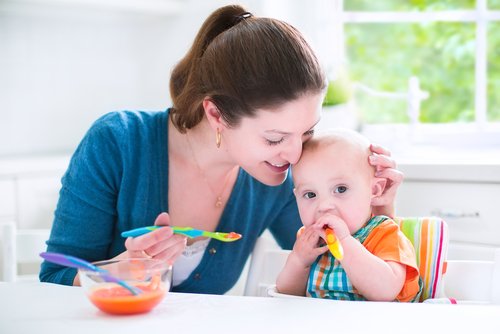Tips for Establishing Your Baby's Feeding Routine

Establishing a feeding routine is key to helping your baby grow up healthy and strong.
As children grow and develop, they need to incorporate new foods into their diet. Parents should be especially careful in regards to what foods they give their children according to age.
When to start establishing a feeding routine
From the time babies are born, parents can start establishing routines in regards to their activities. This doesn’t only involve feeding, but also naps, baths and hygiene.
Establishing routines not only helps children gain healthy habits, but also helps the entire family become more organized.
Once babies reach 3 months of age, they become more aware of the various activities they do every day. This also means they notice when they carry out new activities that they aren’t used to.
The first routine that babies learn has to do with eating. That’s why parents should pay special attention to their baby’s nourishment and how to adapt it over time.
The advantages to establishing a feeding routine for your baby
The first thing that parents should do before introducing new foods into their baby’s diet is to consult with the pediatrician. Small children cannot eat certain foods because they may cause harm.
Establishing eating schedules will help your child get used to meal times. Below are more important advantages:
- Helps babies get to know their own routines and schedules. For example, they know that, after nap time, they’ll get a bottle.
- It will be much easier when the time comes for parents to leave their baby to someone else’s care. Be it a nanny or a family member, having a feeding routine established will help caregivers maintain these habits.
- Establishing a feeding routine for babies is also important in organizing biological processes – specifically, the processes that have to do with the gastrointestinal tract and nutrition.
- When babies start to ingest new foods, an established routine helps parents recognize if any foods produce allergies or intolerances.

Most common schedules
There are three types of routines that parents can start to apply. The first is the one that parents themselves impose. The second is the one that the baby decides. And the third is a combination of the first two.
We’ll explain each of the feeding routine options in more detail below:
Feeding routine established by parents
This type of schedule tends to be the most strict. Parents decide just when their babies will eat. Also, on some occasions, they also determine how much their babies sleep, eat and play.
In order for parents to start establishing this sort of routine, they should speak directly with an expert. They can also base these routines on their child’s natural patterns. They should be precise and repeat the same routine every day.
“Establishing a routine is important. Parents must remember that babies need to eat at least every 4 hours.”
Feeding routine established by the baby
This sort of routine tends to be more flexible and less precise. In this case, parents usually allow their child’s signals to be their guide. In other words, they allow their child’s behavior to signal what he or she needs.
This doesn’t mean their children will never get organized. When babies are born, they start to establish regular times for sleeping, eating and playing. It’s important for parents to observe and respect these naturally established schedules.
Combined routines
This technique applies a combination of the two previous methods. Parents should follow an established routine for sleeping, eating and playing.
But some of these times can change. For example, sleep times can sometimes wait in the case of a trip to the supermarket or another activity.

How much should babies eat?
There’s no specific amount of food that babies should eat. Once babies start their complementary diet, specialists recommend starting off by offering 1 or 2 spoonfuls of food.
Each day, they can increase this amount progressively, as long as the baby likes it. Although it’s also important to remember that children should eat according to their own individual needs and demands.
It’s fundamental for parents to go about establishing a feeding routine the right way. In the same way, a child’s feeding habits should match his or her age.
Remember that if you have any questions about your child’s diet, you should talk to your little one’s doctor.
The same is true if you have any doubts about introducing a specific food. An adequate diet and feeding routine will contribute to your child’s healthy growth and development.
Establishing a feeding routine is key to helping your baby grow up healthy and strong.
As children grow and develop, they need to incorporate new foods into their diet. Parents should be especially careful in regards to what foods they give their children according to age.
When to start establishing a feeding routine
From the time babies are born, parents can start establishing routines in regards to their activities. This doesn’t only involve feeding, but also naps, baths and hygiene.
Establishing routines not only helps children gain healthy habits, but also helps the entire family become more organized.
Once babies reach 3 months of age, they become more aware of the various activities they do every day. This also means they notice when they carry out new activities that they aren’t used to.
The first routine that babies learn has to do with eating. That’s why parents should pay special attention to their baby’s nourishment and how to adapt it over time.
The advantages to establishing a feeding routine for your baby
The first thing that parents should do before introducing new foods into their baby’s diet is to consult with the pediatrician. Small children cannot eat certain foods because they may cause harm.
Establishing eating schedules will help your child get used to meal times. Below are more important advantages:
- Helps babies get to know their own routines and schedules. For example, they know that, after nap time, they’ll get a bottle.
- It will be much easier when the time comes for parents to leave their baby to someone else’s care. Be it a nanny or a family member, having a feeding routine established will help caregivers maintain these habits.
- Establishing a feeding routine for babies is also important in organizing biological processes – specifically, the processes that have to do with the gastrointestinal tract and nutrition.
- When babies start to ingest new foods, an established routine helps parents recognize if any foods produce allergies or intolerances.

Most common schedules
There are three types of routines that parents can start to apply. The first is the one that parents themselves impose. The second is the one that the baby decides. And the third is a combination of the first two.
We’ll explain each of the feeding routine options in more detail below:
Feeding routine established by parents
This type of schedule tends to be the most strict. Parents decide just when their babies will eat. Also, on some occasions, they also determine how much their babies sleep, eat and play.
In order for parents to start establishing this sort of routine, they should speak directly with an expert. They can also base these routines on their child’s natural patterns. They should be precise and repeat the same routine every day.
“Establishing a routine is important. Parents must remember that babies need to eat at least every 4 hours.”
Feeding routine established by the baby
This sort of routine tends to be more flexible and less precise. In this case, parents usually allow their child’s signals to be their guide. In other words, they allow their child’s behavior to signal what he or she needs.
This doesn’t mean their children will never get organized. When babies are born, they start to establish regular times for sleeping, eating and playing. It’s important for parents to observe and respect these naturally established schedules.
Combined routines
This technique applies a combination of the two previous methods. Parents should follow an established routine for sleeping, eating and playing.
But some of these times can change. For example, sleep times can sometimes wait in the case of a trip to the supermarket or another activity.

How much should babies eat?
There’s no specific amount of food that babies should eat. Once babies start their complementary diet, specialists recommend starting off by offering 1 or 2 spoonfuls of food.
Each day, they can increase this amount progressively, as long as the baby likes it. Although it’s also important to remember that children should eat according to their own individual needs and demands.
It’s fundamental for parents to go about establishing a feeding routine the right way. In the same way, a child’s feeding habits should match his or her age.
Remember that if you have any questions about your child’s diet, you should talk to your little one’s doctor.
The same is true if you have any doubts about introducing a specific food. An adequate diet and feeding routine will contribute to your child’s healthy growth and development.
All cited sources were thoroughly reviewed by our team to ensure their quality, reliability, currency, and validity. The bibliography of this article was considered reliable and of academic or scientific accuracy.
- Lázaro A, Martín B. Alimentación del lactante sano. Protocolos diagnóstico-terapéuticos de Gastroenterología, Hepatología y Nutrición Pediátrica SEGHNP-AEP. 287-295. [Disponible en línea].
- Organización Mundial de la Salud/ Organización Panamericana de la Salud. “La alimentación del lactante y del niño pequeño: Capítulo Modelo para libros de texto dirigidos a estudiantes de medicina y otras ciencias de la salud”. 2010. ISBN: 978-92-75-33094-4
This text is provided for informational purposes only and does not replace consultation with a professional. If in doubt, consult your specialist.








